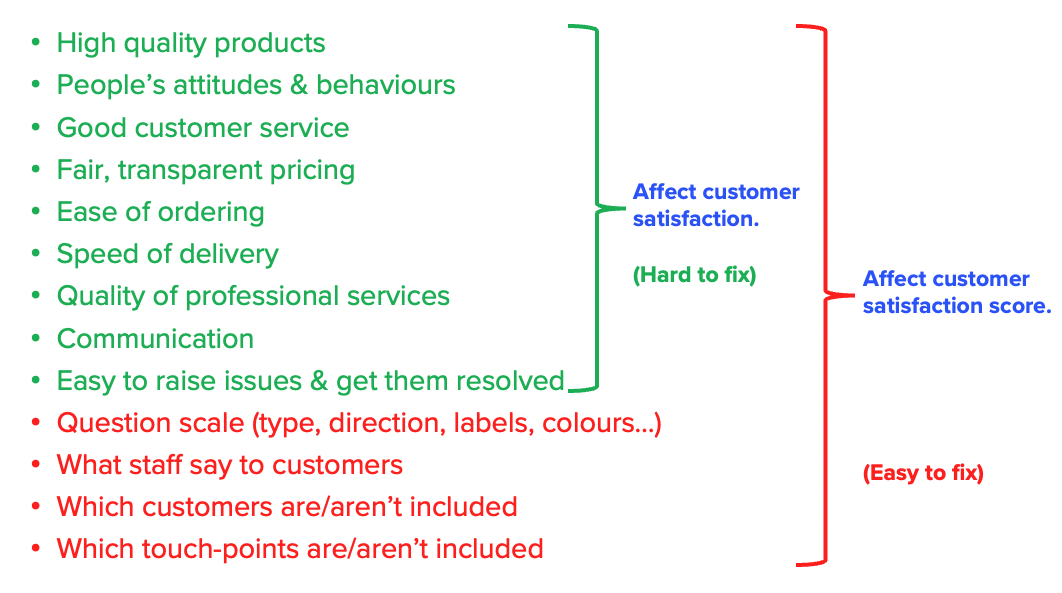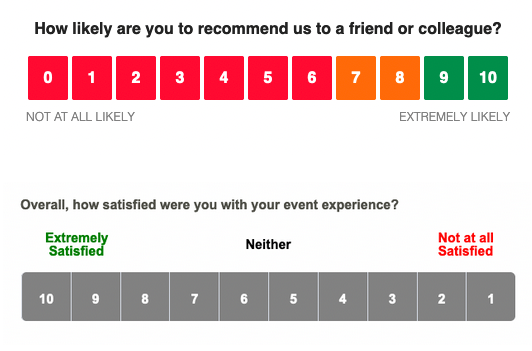

Learn how to drive financial improvements in your business by improving customer experience… And why setting a target for customer satisfaction is such a bad idea.
It goes without saying that everyone wants a high score for customer satisfaction – or Net Promoter Score (NPS), or CSat, or Customer Effort Score, or however you want to measure overall satisfaction.
And of course, setting targets is a great way to accelerate improvements – targets help people focus their efforts and they provide visibility of progress towards a goal.
But setting a target for satisfaction itself is a bad idea.
You may well get a higher score, and if you attach a bonus payment you’ll definitely get a higher score, but you’ll also discover that people find plenty of resourceful ways to get a higher score without making customers happier or the business better.
The first reason is because satisfaction is subjective. A subjective measure is not a bad thing. But putting a number on something that’s subjective does not make it objective.
Subjective measures, like customer satisfaction, or NPS, are still useful – because by expressing a feeling or sentiment on a scale you can gauge the severity.
Is your customer so happy and confident in you that they’ll be prepared to risk their personal reputation by recommending you to others? Or are they a little unhappy due to a minor problem that you can quickly fix? Or are they hanging on by a thread and you’re in danger of losing them?
It helps to know where they are on the scale, and it’s really easy for them to tell you, but it’s pointless (and nonsensical) for it to be accurate to two decimal places.
Customer satisfaction is not the only area in business which is susceptible to poor targets being chosen. Goodhart’s Law, a principle established by economist Charles Goodhart in 1975, can be summarised as, “When a measure becomes a target, it ceases to be a good measure.”
An objective measure, on the other hand, is much better suited to target setting. Being objective means it’s deterministic – several people can measure the same thing and get the same result.
It’s also repeatable, and it’s harder to manipulate. For example, how long it takes you to answer phone calls, deliver your products or respond to email enquiries. Or how many customers your business has gained and how many it has lost in the last twelve months. It’s about objective facts not subjective feelings.
Where subjective measures come in handy is for finding out whether or not a problem exists, and how seriously it’s affecting customer sentiment.
Measuring overall satisfaction is not an exact science.
Fortunately, it doesn’t need to be – when the (subjective) satisfaction measure has revealed a problem (and the severity), then its work is done, and it’s time to choose different, objective measures that are better suited to targeting.
A low satisfaction score tells you there’s a problem, but making the score higher doesn’t fix the problem.
Just like having a high temperature shows that you’re ill – the cure is not treating the symptoms with an ice bath, but treating the cause of the problem.
Understanding that Net Promoter Score (NPS) and other satisfaction measures are proxies is the key to understanding why it’s unwise to set a target for NPS or customer satisfaction.
By ‘proxy’ we mean it’s one convenient representative of several other things.
When a customer gives a satisfaction score they’re summing up in one simple number, that’s easy to collect and easy for the customer to judge, how well you’re doing as an organisation at the whole range of things that are important to them in their dealings with you.
So a single ‘satisfaction’ score represents various factors, depending on your type of business, such as:
In giving an overall satisfaction score, or how likely they’d be to recommend you, a customer will be taking into account all aspects of their experience. These are just examples, in your company there may be more or there may be just a few, but there will be certain things that customers want you to be brilliant at and it’s how you perform on a combination of those measures that will determine what overall satisfaction score they give.
Those specific aspects of performance that are most important to customers are your starting point for choosing better targets. When you set targets you need to adopt a more granular approach.
The critical mistake is to assume that setting a target for satisfaction score will result in improvements to the things that really matter to customers.

It’s easy to increase satisfaction score without increasing satisfaction.
Actually, setting a target would be reasonable if the satisfaction score depended on those factors alone because you could only improve it by improving things which directly improved customer experience. But that’s not the case. Satisfaction scores are influenced by other inputs which are less obvious, too – inputs which can be manipulated to increase the satisfaction score.
For example, satisfaction scores can be skewed by what your people say to a customer if they know a survey will be sent. Or by arranging for surveys not to be sent in some cases. They can be skewed by the visual design, adding hints or colours to the satisfaction scale. Some companies even try to get a higher score by reversing the direction of the scale, scoring from 10 to 0 instead of 0 to 10.
These other influences might sound trivial, and you’d like to think your people would focus on the wholesome, underlying factors which will improve customer experience. But the reality is – if you place a target on satisfaction, people will go for the easiest ways to increase the number. All the more so if they’ll get a bonus for hitting the satisfaction target.
It’s usually very easy to spot surveys that come from organisations who have set a satisfaction score as a target, and this can make customers cynical about the process.

Don’t try and nudge the score by playing mind games with the scales.
These shortcuts and others can give you a higher score, but they absolutely do not mean there’s been an improvement in the things that customers value.
This means three bad things have happened:
This is a big deal, because only by improving the important factors will you see an improvement in things which will make a positive impact on your business – customer retention, customer recommendations, spend per customer and reputation.
The creator of NPS, Fred Reichheld, discourages targets for NPS because it can be manipulated: “I had no idea how people would mess with the score to bend it, to make it serve their selfish objectives.”
The surprising thing is – low scores can make you the most money, which is yet another reason why deterring them is not a wise move.
If you can spot a customer at risk, who would previously have gone undetected, you can retain someone you would otherwise lose. Of course there’s momentary horror when you get a bad score. But turn them round and it’s more cash on the bottom line because every new customer is then an addition rather than a replacement.
In short, it’s not at all unusual for people to be paid bonuses for increasing the customer satisfaction score, probably even feeling a worthy sense of achievement for hitting their target, while revenue, profitability, customer numbers and reputation may have declined.
Good targets are those which can only be met by improvements which will demonstrably improve customer experience, and which can’t be achieved by manipulating other factors.
Well chosen targets lead to concrete financial benefits for the business such as higher profits from customer retention, more new customers via personal recommendations and higher average spend.
A spin-off benefit is that this means you’re improving the things which are attractive to ‘higher quality’ customers (for example, those who have a higher lifetime value). Whereas the customers who are the most price sensitive can also be the most… demanding.
So choose targets which will tangibly improve customer experience, knowing that your satisfaction score will increase as a result, rather the other way round.
To recap, we’re looking for specific targets that will improve the things which are most important to customers, which can’t be fudged, and which will result in an increase in overall satisfaction, or Net Promoter Score.
In turn that means the business will benefit, for all the right reasons, because by improving in these areas you will improve:
Some examples of targets you could set for improving quality:
Some examples of targets you could set for improving customer service:
It wouldn’t be wise to set them all at once. But it’s never too early to start making improvements.
Begin by measuring satisfaction with the things that you know are most important to your customers so you can uncover any problem areas.
The best way to do this is to invite customer feedback at key steps in the customer journey. Different factors, or combinations of factors, will be important at each step. Measuring them with focused satisfaction questions will tell you where your strengths and weaknesses are and you can assess the importance and urgency of corrective actions.
By setting targets for each specific factor, you’ll achieve a higher score for satisfaction overall.
The difference is that your higher score will have been earnt by making customers’ lives better, and the results will show in the bottom line.
Also, you don’t have to keep the same targets for ever – once you’ve fixed the first underlying problems that you’ve discovered, and you’re consistently scoring well there, you can remove that question from your survey and shine the spotlight somewhere else.
Nobody expects perfection – so if you’re normally great, and you make it amazingly easy to fix the occasional problem, then you’re the ideal supplier for every reasonable customer out there. What’s more, most of us would be happy to lose the unreasonable customers to our competitors!
Next time we send a newsletter, you’ll receive it.
We hope you love it, but if you don’t, it’s easy to unsubscribe.
Connect with a CX expert who’ll help determine your current VoC programme maturity level and provide a 3-step action plan to improve.